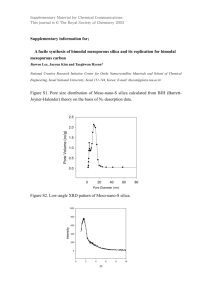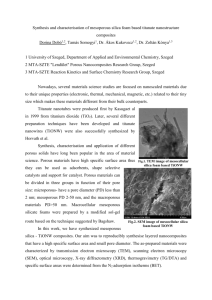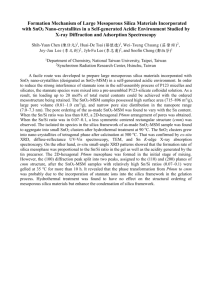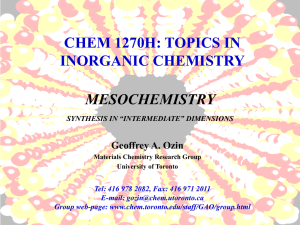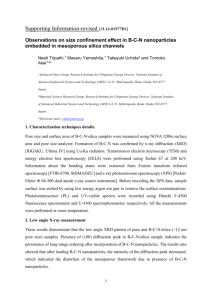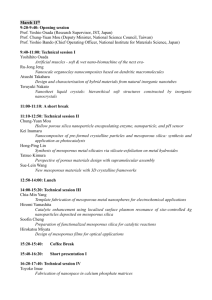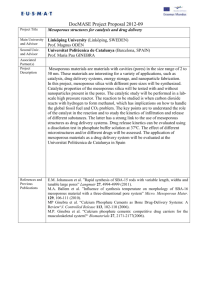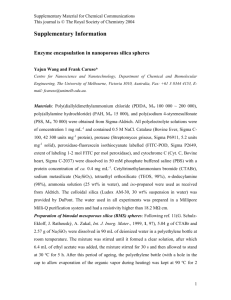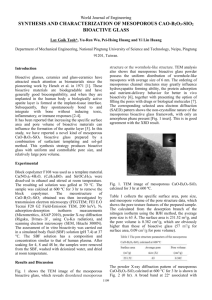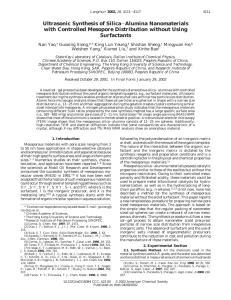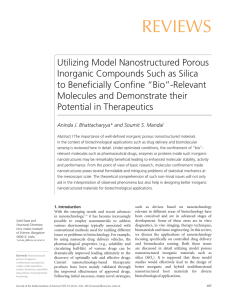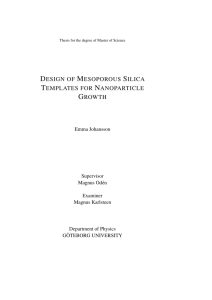Experimental details - Royal Society of Chemistry
advertisement
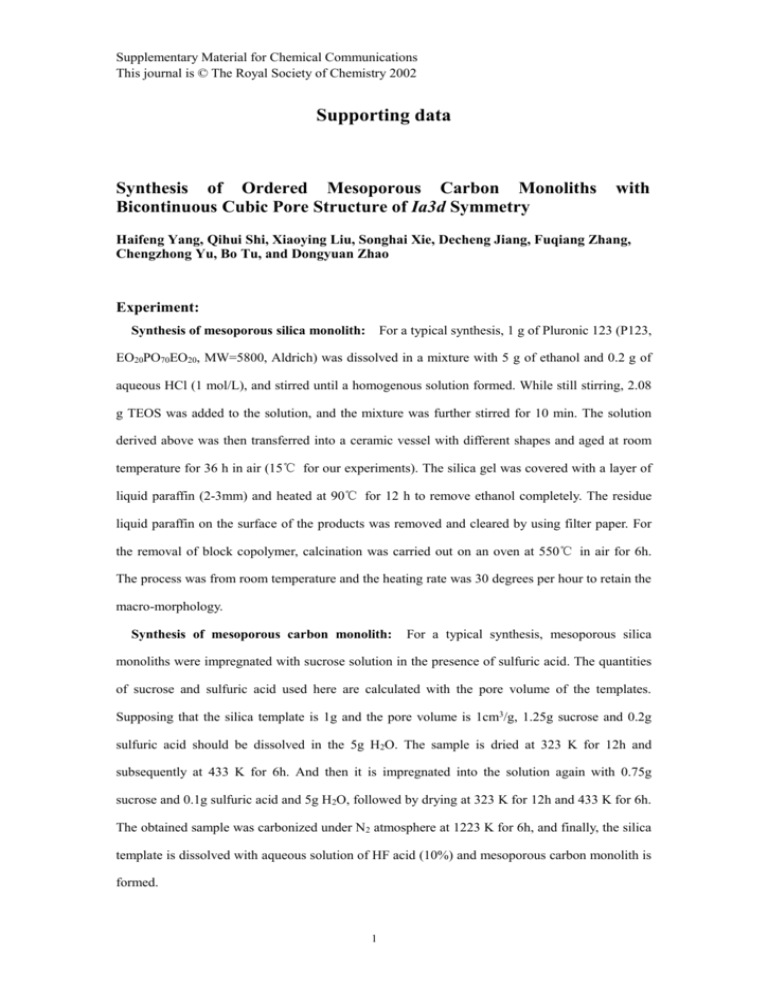
Supplementary Material for Chemical Communications This journal is © The Royal Society of Chemistry 2002 Supporting data Synthesis of Ordered Mesoporous Carbon Monoliths Bicontinuous Cubic Pore Structure of Ia3d Symmetry with Haifeng Yang, Qihui Shi, Xiaoying Liu, Songhai Xie, Decheng Jiang, Fuqiang Zhang, Chengzhong Yu, Bo Tu, and Dongyuan Zhao Experiment: Synthesis of mesoporous silica monolith: For a typical synthesis, 1 g of Pluronic 123 (P123, EO20PO70EO20, MW=5800, Aldrich) was dissolved in a mixture with 5 g of ethanol and 0.2 g of aqueous HCl (1 mol/L), and stirred until a homogenous solution formed. While still stirring, 2.08 g TEOS was added to the solution, and the mixture was further stirred for 10 min. The solution derived above was then transferred into a ceramic vessel with different shapes and aged at room temperature for 36 h in air (15℃ for our experiments). The silica gel was covered with a layer of liquid paraffin (2-3mm) and heated at 90℃ for 12 h to remove ethanol completely. The residue liquid paraffin on the surface of the products was removed and cleared by using filter paper. For the removal of block copolymer, calcination was carried out on an oven at 550℃ in air for 6h. The process was from room temperature and the heating rate was 30 degrees per hour to retain the macro-morphology. Synthesis of mesoporous carbon monolith: For a typical synthesis, mesoporous silica monoliths were impregnated with sucrose solution in the presence of sulfuric acid. The quantities of sucrose and sulfuric acid used here are calculated with the pore volume of the templates. Supposing that the silica template is 1g and the pore volume is 1cm3/g, 1.25g sucrose and 0.2g sulfuric acid should be dissolved in the 5g H2O. The sample is dried at 323 K for 12h and subsequently at 433 K for 6h. And then it is impregnated into the solution again with 0.75g sucrose and 0.1g sulfuric acid and 5g H2O, followed by drying at 323 K for 12h and 433 K for 6h. The obtained sample was carbonized under N2 atmosphere at 1223 K for 6h, and finally, the silica template is dissolved with aqueous solution of HF acid (10%) and mesoporous carbon monolith is formed. 1 Supplementary Material for Chemical Communications This journal is © The Royal Society of Chemistry 2002 Figure 1. TEM images of calcined mesoporous silica monolith template with cubic mesostructure of Ia3d symmetry along the (a) [111] and (b) [311] direction. Inset is the electron diffraction along [111]. The silica monolith template was prepared by using triblock copolymer as a template under a an acid condition direction. TEM photographs were obtained with a JEOL JEM2011 microscope operated at 200 kV. b a Figure 1 2 b Supplementary Material for Chemical Communications This journal is © The Royal Society of Chemistry 2002 Figure 2. Nitrogen adsorption isotherms and pore size distribution curve (inset) of mesoporous silica monolith with cubic mesostructure of Ia3d symmetry. N2 adsorption measurements were performed at 77 K using a Micromeritics Tristar 3000 analyzer utilizing Barrett–Emmett–Teller (BET) calculations for surface area and Barrett–Joyner–Halanda (BJH) calculations for pore volume and pore size distributions for the adsorption branch of the isotherm. The mean pore diameter is calculated to be 5.15 nm. The BET surface area and the total pore volume are 450 m2/g and 0.67 cm3/g, respectively. Figure 2 3 Supplementary Material for Chemical Communications This journal is © The Royal Society of Chemistry 2002 Figure 3. Nitrogen adsorption isotherm and pore size distribution curve (inset) of mesoporous carbon monoliths with bicontinuous cubic mesostructure of Ia3d symmetry. The mean pore diameter is calculated to be 4.58 nm. The BET surface area and the total pore volume are 1530 m2/g and 1.93 cm3/g, respectively. Figure 4 The volt-ampere characteristics of the mesoporous carbon monolith. This I-V curve was measured using a CHV1610 electrochemical workstation with a 1 7 3 mm carbon monolith. The red line is the linear fit of the experimental data. 0.006 Current (A) 0.004 0.002 0.000 -0.002 -0.004 -0.006 -0.06 -0.04 -0.02 0.00 0.02 Potential (V) 4 0.04 0.06 Supplementary Material for Chemical Communications This journal is © The Royal Society of Chemistry 2002 5
